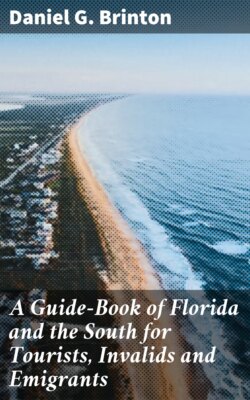Читать книгу A Guide-Book of Florida and the South for Tourists, Invalids and Emigrants - Daniel G. Brinton - Страница 14
На сайте Литреса книга снята с продажи.
Charleston.
ОглавлениеHotels.—*Charleston Hotel, Mills House (newly furnished), both on Meeting Street. Charges, $4.00 per day. *Pavilion Hotel. Mr. Butterfield, proprietor, $3.00 per day, also on Meeting Street. Planter’s Hotel, Church Street, Victoria House, King Street, both $2.50 per day.
Telegraph Office, on Broad near Church Street; branch office in Charleston Hotel.
Post Office, on Hazel Street, near Meeting.
Churches.—Roman Catholic, Episcopal, Huguenot, Methodist, &c.
Theatre, at the corner of King and Market Streets.
Bathing Houses.—One of salt water near the battery; two, with water of the artesian well, one at the well, the other in the Charleston Hotel.
Livery Stable, 21 Pinckney Street, connected with the Charleston Hotel.
Street Cars run on several of the streets; fare, 10 cts., 15 tickets for $1.00. All the hotels have omnibuses waiting at the depots.
Physician.—Dr. Geo. Caulier, 158 Meeting Street.
Newspapers.—The Daily Courier, the Daily News.
Depots.—The depot of the Northeastern R. R. from Wilmington to the north, is at the corner of Chapel and Washington Sts.; that of the road to Savannah is at the foot of Mill street; and that of the S. C. R. R. to Aikin, Augusta, Atlanta, etc., is in Line street, between King and Meeting streets.
Bookseller.—John Russell, 288 King street. (Brinton’s Guide-Book.)
Libraries.—Charleston library, 30,000 vols.; Apprentices’ library, 12,000 vols.
Charleston claims 40,000 inhabitants, the whites and blacks being about equal in number. It is curious that since the war the mortality of the latter has been twice as great as of the whites.
The city is seven miles from the ocean at the junction of the Ashley and Cooper rivers, and has an excellent harbor, surrounded by works of defence. On the sea line is Fort Moultrie; Castle Pinkney stands at the entrance to the city; south of the latter is Fort Ripley, built of palmetto logs; while in the midst of the harbor stands the famous Fort Sumter.
The ravages caused by the terrible events of the late war have yet been only very partially repaired in Charleston. The greater part of the burnt district is deserted and waste.
The history of Charleston, previous to that event, is not of conspicuous interest. The city was first commenced by English settlers, in 1672, and for a long time had a struggling existence. Many of its early inhabitants were Huguenots, who fled thither to escape the persecutions which followed the revocation of the edict of Nantes. A church is still maintained in which their ancient worship is celebrated.
Of public buildings, the ancient church of St. Michael’s, built about 1750, has some claim to architectural beauty.
The fashionable quarter of the city is the Battery. *Magnolia cemetery, on the Cooper river, is well worth a visit. It is one of the most beautiful in the South. It was laid out in 1850, and contains some handsome monuments.
The Custom House is a fine building, of white marble.
Those who wish to visit Fort Sumter, and review the scenes of 1861, can be accommodated by a small sailing vessel, which leaves the wharf every morning at 10.30 o’clock.
In the church-yard of St. Philip’s is the tomb of John C. Calhoun. A slab, bearing the single word “Calhoun,” marks the spot.
The museum of the Medical College is considered one of the finest in the United States.
